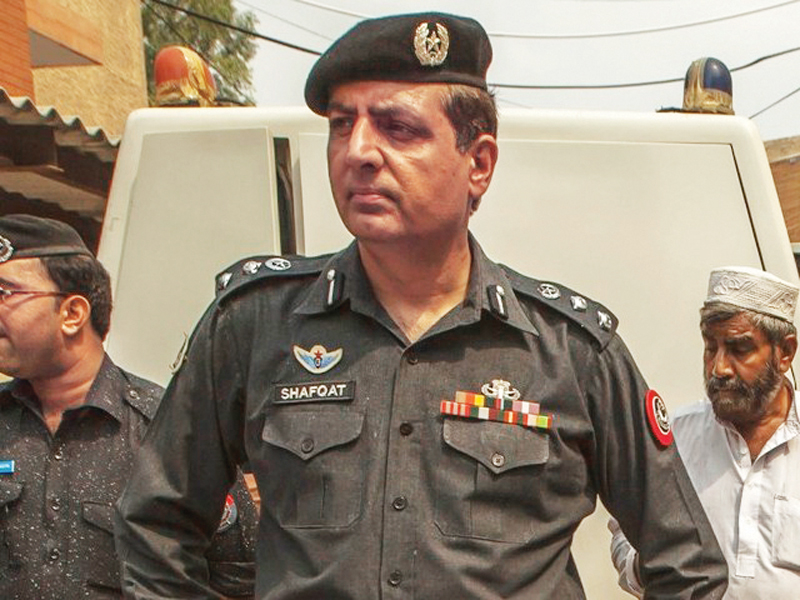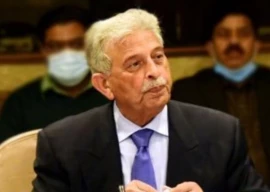
Reading a book will teach you, but the field is where you learn, says AIG Special Branch Shafqat Malik.
The head of the bomb disposal unit (BDU) is a chatty, confident chap. It is easy to see where he gets his self-assured demeanour; Malik has been working since the last 27 years – the army, the Federal Investigation Agency (FIA) and now the BDU. Although it was functional before he joined, Malik has in a sense raised the unit to what it is and what he plans for it to become. “It’s the only such unit in the country,” he claims proudly.
When The Express Tribune spoke to Malik on the telephone earlier in the year, he had been trying to wrangle with the Pakistan Tehreek-e-Insaf (PTI) government to regularise members of his force and give them a service structure so he can incentivise them with promotions.
“I worked five years for this, they have finally agreed to a Rs5,000 allowance per person per month but no one has received it as yet.” The rest is still stuck in red tape.
From hugging suicide bombers to recreating tricky crime scenes, Malik has been there and thankfully survived. He might come across as a bit of a cocky maverick; there’s also some homage to Sergeant First Class William James from The Hurt Locker, a movie which Malik feels strongly about.
“Personality is very important in defusing bombs. Lots of trained people reach bomb sites and lose courage. You need to be very calm and bold,” shares Malik.
“Facing death is not so simple. You have to overcome the fear.”
Sealed with a kiss
It’s a signature, a bomb. Like in a crime show, a letter sealed with a kiss, loaded with DNA. Before a bomb explodes and after, it leaves traces of its makers.
The type of device is the first clue. “There are many trends; it depends on the culprits’ logistic capability, what’s in their store, and what accessories they possess.” Malik shares many bombs have remotes, some are timed devices, some have 100 switches, others are in pressure cookers.
“Every group has a specific pellet size and trigger systems which could be electric or mechanical. You have to see the grade of explosive used. Then you build a profile.”
The next clue lies in how skilled the bomb builder is in his craft, “their expertise”.
Malik says you can make out the signature of any group with the right forensic analysis, skills he honed during his time with the FIA, “I can take investigators right to the militants’ door.”
A bombing on a Muharram procession in Karachi in 2009 left local authorities flummoxed over the type of device used. “The centre asked me to reinvestigate, ‘Just reconstruct the crime scene, do us that favour’ and so we did at midnight.”
It turns out the device was in a box meant to hold a Quran. He explains if there is no crater, if the blast is above surface, the most obvious culprit is a suicide bomber, “but that doesn’t mean it’s always so.”
“The bottom line is always your crime scene.”
Talking more about signature tells, Malik walks us through a post blast site in Iqbal Town, Lahore in 2008. “We found a suicide bomber’s remains, but he had his chest intact unlike most suicide attackers. But we found them, a local Punjabi group which doesn’t wear jackets but belts.”
The Hurt Locker starts with a quote from the book War Is a Force That Gives Us Meaning, “The rush of battle is a potent and often lethal addiction, for war is a drug.”
Talking to the chuckling, cheery BDU head, it makes sense; for to be able to run into the arms of a suicide bomber, one needs more than just good intent – an adrenaline push.
“In 2012, the police caught a 12-year-old suicide bomber, Bilal. He hadn’t managed to blow himself up and the police had him pinned to the ground,” Malik saw this unfolding on telly when he rushed to the site as a volunteer, inspired by the hallmark bomb squad movie, again.
“I wanted to go save him, of course also myself and others.” After he disarmed Bilal, he hugged the boy. “The media objected to my hugging him,” he recalls, “But I just wanted to check his pockets.”
Anatomy of a blast site
First responders at a crime scene are very important, explains Malik. “But our scene is always contaminated. “
He says the moment you enter the site, you contaminate it with footprints, with fingerprints; as soon as you touch anything at the scene your trace elements are hard to extract and distinguish.
“We have an inner cordon for the epicentre; 20 metres is the outer cordon. The inner cordon should only be entered by forensic experts. You can divide the scene using a grid system, and search it.”
With one person commanding the scene, the others just identify things within the grid. “They photograph evidence, they tag things wearing gloves – you always have to wear gloves.”
“You swab objects for chemicals, and if you touch anything without protective gear, you cannot undo the contamination.”
The aim is to identify the signature to link the scene with the culprit. And then you understand the pattern – the switches, triggers, type of explosives all tell you a tale.
The post blast site also poses a risk to one’s life, as Hukam Khan unfortunately experienced. “You are exposed to a possible second device and remnants of explosives.”
Malik explains the direction of the interaction of the device and its blowback matter. All these things matter, “because you have to prove yourself in court, weak prosecution is the main reason behind acquittals.”
But, he ends on despondent note, “We lack the resources to do all this.”
Suit up
By early January 2014, Malik shares the BDU had lost over 11 people in under seven years. And he feels more could have been done to save some of those lives. Five thousand bombs had also been defused in this period, including a 4,500kg truck bomb in Karak in May 2013. “People aren’t recognising the BDU, they aren’t considered to be part of the police – if you mainstream them, they will have a budget.”
“We need bulletproof vehicles, we get targeted when we travel.”
More than recognition, Malik just wants his team, his men to be appreciated because that would be the obvious thing to do. “We play with life and death, why should we beg for medals?”
Published in The Express Tribune, February 21st, 2014.
COMMENTS (14)
Comments are moderated and generally will be posted if they are on-topic and not abusive.
For more information, please see our Comments FAQ

































1714024018-0/ModiLara-(1)1714024018-0-270x192.webp)









The Government must look and appreciate the function of this organization. They should be equipped with latest technology. We may require foreign experts and must not hesitate to hire them Cameras be fitted on every points instead of Nakas
I just found another personal hero. Shafqat Malik, you are an inspiration and a hero to not just me but all peace-loving citizens. May you stay safe and may there be less need for your bomb-defusing skills as time goes on.
What a brilliant story, well done
This is what ballsy is.
Respect sir. We are proud to have people like him in our country. India make movies where they show actors diffusing bombs. They should learn from these people who carry out their jobs on the ground rather than showing it off in some movie.
Great respect for him. It is people like him and other security officials who toil all day fro our safety. May God bless him. Ameen
Full marks to people like him.
It is a tough job! Huge number of citizens and police officials watches one man heading towards a live bomb. You dont know whether you will come back walking or you will be stretchered away. It is tough for family too, but something to be proud of!
I know all this really well as i am a proud grandson of Moenuddin (Late), Ex Cheif Bomb Disposal Squad, Karachi.
Farooq
Salute to these people who are serving this nation where politicians are busy in looting the country.
Somehow ET kept its PTI phobia alive. ANP was not criticised for the same reason even after 5 years but it is religious duty of ET to criticize PTI
He is afflicated with Ch Shujaat. Pl get these imp people insured for Rs 50 lacs. Their life is at stack on daily basis. Thanks to indecisiveness of Kiyani and now NS
Keep up the great work! BRAVO!